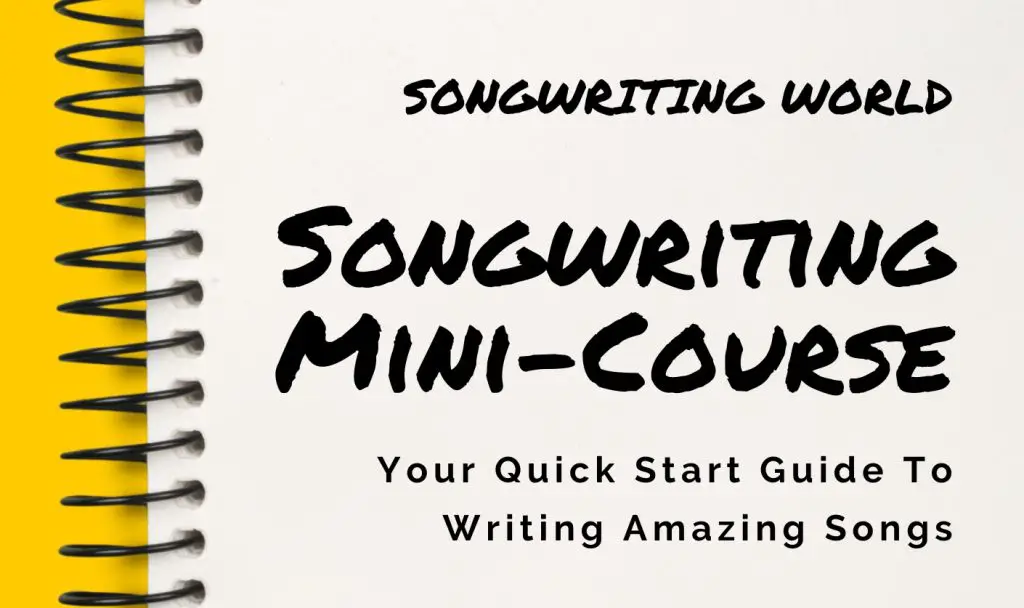

You can learn how to create wonderful songs that are compelling and memorable by learning about the fundamentals of songwriting. Here are 12 Songwriting Tips to help you get started:
1. Create a memorable melody.
The melody is the most essential part of a song and the part that sticks in people’s minds. The melody should be very memorable and should create an emotional response in the listener. It’s important to come up with a melody that is both catchy and original.
It’s important to create a melody that stands out and doesn’t sound like any other song. Additionally, the melody should be memorable and evoke an emotional response from the listener. The vocal line is also very important and can be as catchy as the melody or as brief as a one-syllable word.
2. Create a great chord progression
The chord changes in the song should be incredibly catchy and interesting to keep listeners engaged with your music. The chords should move the song forward and create a solid foundation for your melody and rhythm.
Tension and release is a common part of most chord progressions. You can create this by using a chord that has more dissonance than the previous one. Use common chord progressions as the basis of your song, then try adding one or two unusual or uncommon chords. This will make your song more unique and interesting.
3. Focus on Rhythm
Rhythm is an essential part of songwriting. For some people, the rhythm or beat is the most important part of a song. The rhythm is what will get people dancing to your music. It’s important to have a strong, memorable rhythm that will keep listeners engaged.
You can create a strong rhythm by using common rhythms that have proven to be popular in the past. Additionally, you can use syncopation and accents to add interest and make the rhythm more dynamic. Experiment with different rhythms until you find one that you like.
Try writing some songs while these rhythms are playing, it’ll inspire a lot of new ideas:
- 4 on the Floor – Popular in EDM, swing, and disco music
- Bo Diddly Beat
- The Two Beat
- Boom-Bap
- Dem Bow Beat (popular in reggaeton and Latin dance music)
- “Impeach the President” drum beat – Named after the song “Impeach the President” by the Honeydrippers
- 12/8 Feel / Drum beat – Great for ballads and slow songs
- Shuffle drum beats (there are many variations) – A great example is “Rosanna” by Toto
4. Create a Groove
A rhythmic groove could be just what your song needs. The groove is the rhythm and feel of your beat. It’s what will get people moving to your music. A groove is created between the interplay of drums and the bass.
The groove should be tight and locked in with the drums and bass. It’s important to have a strong groove that people can move to. You can achieve this by using common grooves that are popular in music. Use this as a foundation, then add your own twist to make it interesting and original.
5. Write the Song Around a Great Hook
A hook is what will get people interested in your music and sing along with you at live performances. It’s also an essential element to getting stuck in people’s heads.
A catchy hook can be just about anything, but it has to be short enough that it doesn’t overstay its welcome on the listener’s mind. It’s also important to make sure the hook is related to the overall message of the song.
Come up with a strong, catchy hook that will stick in people’s minds. It doesn’t have to be words, it can be nonsense or just syllables sung over and over again.
Some examples of catchy hooks are:
- “I like big butts and I cannot lie” – “Baby Got Back” by Sir Mix-A-Lot
- “Doot doot doo” – “Semi-Charmed Life” by Third Eye Blind
- “Can’t touch this” – “U Can’t Touch This” by MC Hammer
- “I’m blue, da ba dee, da ba die” – “Blue (Da Ba Dee)” by Eifel 65
- “Mmm bop” – “MMMBop” by Hanson
6. Write the song around a great riff
A riff is an instrumental part that repeats. Usually, it’s about four to eight measures long. The riff can become the backbone of your song and should be interesting and catchy enough to hold people’s attention.
Guitar riffs are incredibly popular in rock and metal music. However, that doesn’t mean you can’t use a riff in other genres of music. There are all sorts of riffs to choose from, so find one that best suits your song.
Once you’ve chosen a riff, it’s important to make sure the melody and lyrics fit well with it.
The riff can be based on any chord progression that you like. You can also use a melody as the basis for your riff. Experiment with different chords and melodies until you find something that you like. Once you have a strong riff,
Examples of great riffs in songs are:
- “Seven Nation Army” by White Stripes
- “Bad to the Bone” by George Thorogood
- “Midnight City” by M83
- “Scar Tissue” by Red Hot Chili Peppers
- “Animals” by Martin Garrix
7. Use a Different Instrument
If you’re having trouble coming up with a good melody or chord progression, try using a different instrument to write your song. This can help you come up with new ideas and find inspiration.
Picking up an unfamiliar instrument can help you find new ways of creating melodies and chords. You might also want to try writing songs in a different genre than you’re used to.
You can also use this technique if you feel like your songwriting skills are getting stale. Switching things up can help jump-start your creativity and get the ideas flowing again.
Next time you’re writing a song, why not pick up a ukulele instead of a guitar?
8. Experiment with Different Genres
If you want to become a better songwriter, it’s important to experiment with different genres of music. This will help you learn the fundamentals of songwriting and how to write for different styles.
Some of the biggest hits were unexpected fusions of genres. For example, “Smooth” by Santana is a fusion of rock and Latin music. “Uptown Funk” by Bruno Mars is a fusion of funk and pop.
By experimenting with different genres, you’ll learn what works well and what doesn’t. You’ll also develop a better understanding of how to write songs that are both interesting and unique.
Some examples of songs that blend genres:
“Do You Really Want to Hurt Me” by Culture Club
This song was an unexpected fusion of pop and reggae that became a huge hit.
“The Sign” by Ace of Base
This song was also a reggae fusion, this time with Europop.
“Killing In the Name Of” by Rage Against the Machine
This band made headlines by blending rap and metal into a new, unique sound.
9. Use Different Rhyme Schemes
Try mixing things up by using different rhyme schemes in different songs. For the most part, you want to avoid using the same rhyme scheme for every song. It can get stale and repetitive.
Rhyming is a great way to add structure and make songs memorable. However, if all of your songs have the same rhyme scheme, it will become boring.
There are all sorts of different rhyme schemes to choose from. Some of them are more common than others, but it’s important to experiment until you find one that you like.
Here are some popular rhyme schemes you can try out. The letter represents a verse. Verses with the same letter rhyme with each other.:
ABBA – This is where the first line of each verse rhymes with the fourth line of the verse. The second and third verses rhyme with each other.
ABABCB – In this example, the fifth verse doesn’t rhyme with the other verses at all. It can add weight and stand out by being different.
ABCBDCD – Here we have a more complex rhyme scheme, with four different types of rhymes happening.
Of course, rhyming can get so much more complex. Instead of rhyming single syllables or single words, why not try multi-syllable and multi-word rhymes? Why not create internal rhymes with words inside of verses? The rhyme scheme you come up with can create the basis for a whole new song.
10. Write about Personal Experiences
Everybody has a story to tell. When you write about personal experiences, it makes your songs more relatable to listeners. They can see themselves in your lyrics and connect with the emotions you’re singing about.
Don’t be afraid to tell stories about embarrassing or uncomfortable experiences. These are some of the most relatable stories out there. People love to hear about other people’s embarrassing moments because they can see that they’re not the only ones who go through them.
When you write from personal experience, it also helps to make your songs more authentic and genuine. It shows that you’re not just singing about something you read in a book or saw on TV. You can write songs about anything you want, as long as it’s true to your personal experience and conveys emotion well.
11. Get Creative With Lyrics
The songs that stand the test of time are those that have great lyrics. While music is subjective and people’s tastes vary, lyrics are something that everyone can appreciate.
A song’s production may be dated, but if the lyrics convey something true then people will be able to relate to it for a long time to come.
You don’t have to invent a whole new language to be creative with your lyrics. Instead, just think of unique ways to say the same things we hear every day in pop songs.
One way you can do this is by using metaphors or similes. These make your lyrics more interesting and can help paint a picture in people’s minds.
Use metaphors and similes
“She’s like a drug to me, I’m addicted to her love.”
“I can see the sun but I’m blind without her.”
Change one word of a common saying or expression
You can also get a common expression and change just one word to create a new meaning.
For example, “I second the emotion” was a one-word difference from “I second that motion.”
You can also get a common phrase and add a word to make the meaning strange or unusual.
Here’s an example from the song “Ocean Front Property” by George Strait.
The chorus is, “I’ve got some oceanfront property in Arizona.” Since Arizona isn’t by the ocean, it creates the lyrical idea that the rest of the song is built on.
12. Create a Compelling Story
Everybody loves a great story, and if you can create a song out it, even better. People are hard-wired to pay attention to and listen to stories. The best stories are the ones that people can relate to and that are unusual or interesting in some way.
A song doesn’t need an elaborate story like those in movies or books. It’s possible for something as simple as someone catching their lover cheating on them and their reaction. The story doesn’t have to be about your own life, but it should be something that engages the listener’s emotions.
Start with the “Big Event” in your story
You can tell a story by starting in the middle and then filling in the beginning and end later. The “middle” is the big event that is the most interesting part. This is a great way to keep people engaged, because they’ll want to know what happened before and after the events that you described in your song.
For example, start the story of your “bus ride from hell” at the point where the bus is teetering over the edge of a five-hundred-foot cliff.
Write a song worth remembering
The best songs are memorable and stick in the listener’s mind for a long time. Whether you’re a novice or a seasoned songwriter, following these 12 suggestions will help you get inspired. We hope that the insights in this blog post have given you some new things to try with your next musical masterpiece!
